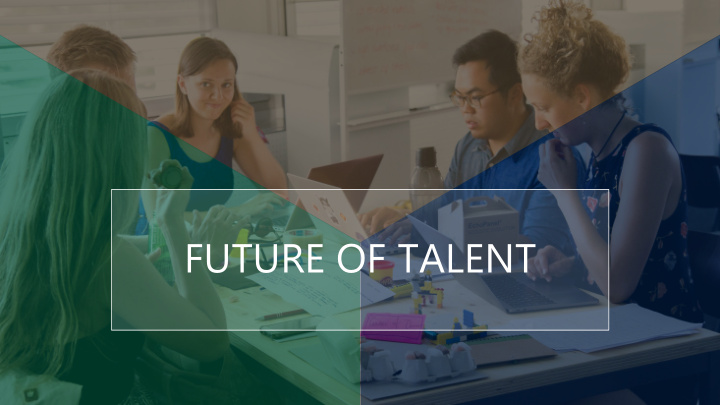



FUTURE OF TALENT
GOOD MORNING
THANK YOU
SPEAKERS Dale Brill Ph. D. Mr. Paul J. Luna Thad Seymour, Ph. D. Senior Vice President, President, CEO Interim President Foundation for Orlando’s Future Helios Education Foundation University of Central Florida Michael Preston Ed. D. Mr. Doug Heckman Executive Director University Data Solutions Florida Consortium of Metropolitan Research Universities EMSI
Welcome Dale Brill, Ph.D. Senior Vice President, Foundation for Orlando’s Future
Opening Remarks Michael Preston, Ed.D. Executive Director, Florida Consortium
Partnership and the Value of Education Mr. Paul Luna President/CEO, Helios Education Foundation
University of Central Florida Fueling the Talent Pipeline Thad Seymour, Ph.D. Interim President, University of Central Florida
Central Florida Talent Outlook Mr. Doug Heckman University Data Solutions, EMSI
The Past and Future of Talent Development Doug Heckman Unive rsity Da ta So lutio ns E msi
Emsi Data Labor market data Job postings Résumés and profiles Data from government Data from job advertisements sources like US Census made by employers (aka Data from online profiles and Bureau and the Department real-time labor market data) résumés created by students of Labor and jobseekers
Delivery Software Consulting API Access labor market data Our team of economists will Pipe our data onto your own online and customize any tailor our data to address webpage for custom design variable at any point. your needs in a customized and display. Accessible anywhere. study.
Our Teams Higher Education Community Insights Enterprise Helping colleges meet the needs Providing labor market & Supplying key insight to help of their regional economy and economic insights to help employers drive talent strategy drive student success. your community prosper. and align recruiting efforts.
Orlando By the Numb e rs
ORLAN ANDO M O MSA Source: Tableau Public, Dakota Mellish, Census Pop. Estimates Migration Data
Orlando Overview
Colleges/ Universities Providing Talent
Top Cit p Cities Orlando, FL: 35% • Tampa, FL: 3% • Miami, FL: 3% • Melbourne, FL: 3% • Oviedo, FL: 2% Jacksonville, FL: 2% • New York, NY: 2% • Winter Park, FL: 1% Atlanta, GA: 1% • Daytona Beach, FL: 1% • Migr gration o of U UCF CF A Alum lumni
Top St p States FL: 61% GA: 4% CA: 3.6% NY: 3.3% TX: 3.3% NC: 2.1% VA: 1.6% Migrat ation o of F f Florida G a Grad aduat ates ( (2- an and 4 4-yea year)
Orlando Seattle
The Challenge Employers struggle to articulate and communicate the • skills they value most Higher ed reads the wrong information or old information • States, regions, and organizations don’t know the • capabilities, aspirations, and potential of incumbent workers Learners are unable to demonstrate what they know and • what they can do
Skills Mapping
Skill Shape Unique skills associated with a given career field, region, or individual.
Education People Work
People Education Emsi Skills Work
Skillify your syllabi People Education Skilla Market bi Emsi Skillscape Skills Regionalized skill clusters Work
Skill Shape Early-adopters The Business Higher Education Forum is utilizing skill shapes to build partnerships • between regional employers, higher education institutions, and workforce and economic development agencies to close those gaps. United Healthcare is one of several companies using skill shapes to understand the • talents of its employees to inform its business strategy and talent-development initiatives. Western Governors University and Southern New Hampshire University have started • using skill shapes
Skill Shape Vision: Employers When employers understand the talent supply in their region, they can target recruitment • efforts and engage in upskilling and reskilling their incumbent workforce, as well as better communicate their skills needs to workers, learners, and learning providers.
Case Study: Medtronic onic Medical device company • MDT (NYSE) - $107.15 • US headquarters: Fridley, MN •
Skill Shape Vision: State and Regional Workforce Enable policymakers, workforce investment boards, and economic developers to understand skill gaps and surpluses in specific regions and allocate scarce workforce development funds to the greatest labor market needs and opportunities for targeted workforce training.
Skill Shape Vision: Higher Education Learning Providers: As employers’ needs come into focus with the use of skill shapes, • learning providers can align curriculum development to real-time workforce needs. Learners: Understanding not only the kinds of jobs but also the specific skills that are in • demand in a region, learners can identify the learning experiences they need to compete for better jobs
Thank You! Doug Heckman – Data Solutions, University Team doug.heckman@economicmodeling.com
Connecting the Talent Pipeline Michael Preston, Ed.D. Executive Director, Florida Consortium
Transforming Learning into Talent for Florida.
Vision We leverage the unique assets of Miami, Orlando, and Tampa Bay to develop talent which enhances community well-being Mission We strengthen Florida’s talent pipeline through the of sharing ideas and scalable solutions which accelerate learner achievement and access to economic opportunity
2019-2023 Focus Areas Active Employability Learning Strategic Populations High Skill Development
The Impact 55% 57% 61% 58% 48% Pell Eligible State College Degrees Earned Total SUS SUS Students Transfers By Minorities Enrollment Minority Enrollment 68% 76% 63% 38K 32K Stay in Florida Employed within Six Year Average Bachelors to work One Year Minority Grad Starting Salary Degrees Awarded Rate Source: 2018 SUS Accountability Report, 16-17 FETPIP Data, Payscale Report
Here’s what we’re working on
Increase Talent Retention in Florida from 76% to 80%
Comprehensive Curriculum Mapping to help students attain in-demand skills
Q & A
SPECIAL THANKS
Recommend
More recommend